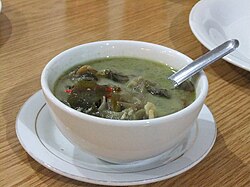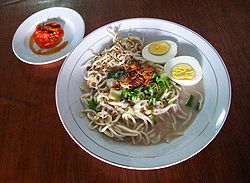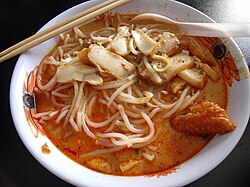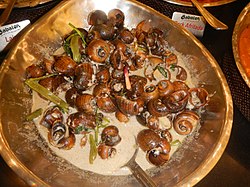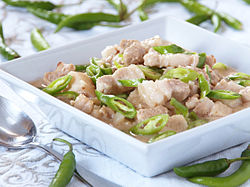By country and region
Caribbean
Sopito is a common fish soup or fish chowder in Aruba and Curaçao of the Lesser Antilles. [5] [6] [7] The dish uses coconut milk and salt-cured meat as main ingredients. [a] Coconut water is also often used to prepare sopito. [8] Sopita de pisca is a variation that uses tomatoes. [9] Coconut and chayote soup is consumed in some areas of the Caribbean. [10]
China
Sago soup is a Chinese dessert soup prepared using sago starch, which is derived from sago palm pith, coconut milk, and other ingredients. [11] [12] [13] [14] Sago is similar to tapioca, and is produced in pearl form. [12]
Indonesia
Some varieties of soto, an Indonesian soup, are prepared using coconut milk, such as soto ayam and soto betawi. [15] Several Indonesian soups also use coconut milk, such as lontong cap go meh , ketupat sayur , opor and sayur lodeh , a vegetable soup in coconut milk. [16] [17]
Palembang's mie celor is noodles in shrimp and coconut soup, [18] [19] while laksan is slices of pempek fish surimi served in coconut-based laksa soup. [20]
Sweet coconut soup dessert includes kolak and cendol , popular for iftar during Ramadan. [b] [c]
- Laksan Palembang
Laos
Tom kha kai is a popular dish in Laos. [23]
Malaysia and Singapore
Laksa is a popular noodle dish with many diverse variants, many of which are prepared with coconut milk, noodles, spices, and meats such as chicken, fish, or shrimp. [24] [25] Tofu and vegetables are also sometimes used as ingredients. [24] [26] [27] [28]
- A variant of Malaysian-style curry laksa
- Kelantanese-style laksa
- A typical bowl of Singaporean-style laksa
- Katong laksa, a variant of Singaporean-style laksa
Philippines
In the Philippines, the very diverse class of soups and stews cooked in coconut milk are collectively known as ginataan . They include both savory and dessert dishes. [29] [30] [31] Savory examples of ginataan soups and stews include ginataang kalabasa , sinilihan , and tiyula itum . Dessert examples include binignit , bilo-bilo , and ginataang mais . [32] [33]
Thailand
Thai Khao soi is a noodle soup dish prepared with egg noodles, coconut milk, curry, and meats such as beef and chicken, and served with pickled mustard greens and raw shallots. [34] Red curry is a Thai soup prepared using coconut milk, meats, and red curry as main ingredients. [35] Tom kha kai (Thai coconut soup) is a Thai soup prepared using coconut milk, chicken, mushrooms, chili peppers, galangal, lemongrass, and other ingredients. [23] [36] Tom yam kathi is a Thai coconut soup and a variant of tom yum prepared using coconut milk. [37]

